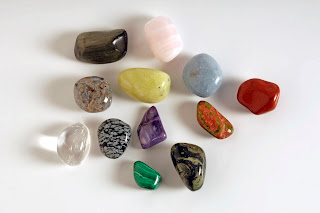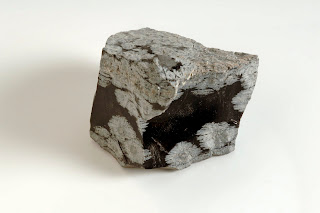'Hurry up, darling. This is boring.'
Edinburgh's famous fossil shop has had fossils for sale from all around the world for over twenty years. This blog is about fossils, minerals and general geology, but also about life in a small shop.
Friday 30 October 2009
Charmer
Eight year-old boy has been looking around the shop with great enthusiasm for ten minutes or so. His parents seem less interested.
Wednesday 28 October 2009
We're gonna need a bigger boat
The skull of a humongous pliosaur has been found in Dorset. Pliosaurs were long-headed, short-necked relatives of the more familiar plesiosaurs. Plesiosaurs were small-headed, long-necked carnivorous marine reptiles. Like Nessie.
This skull measures 2.4m long, putting estimates of the overall length of the sea-beast at around 16m. Very big. The biggest pliosaurs found so far have been from relatively recent finds in Svalbard, a Norwegian island, and Nuevo Leon in Mexico. These finds have been pitched at around 15m, so this Dorset one may be the winner. Given the Norwegian and Mexican examples have been given names like Predator X and The Monster of Aramberri, this new one needs to have a decent name. Not like 'Snappy' or something.
Extrapolating the size of one element of a fossil find is common practice, and understandably so. Everyone is going to want to have an idea of the overall size and shape of an animal to help them picture it. It is clearly an inexact science, however, and errors of scale are frequent. One of the biggest pliosaurs named so far is the mighty Liopleurodon, a scary monster even if it had been memorably exaggerated in the BBC's Walking With Dinosaurs. Some considerable debate has taken place over projected lengths of Liopleurodon, and only the discovery of more intact examples will give a clearer picture of the animal's true size.
Thursday 22 October 2009
Toothy Fruit
One of the smallest dinosaurs found has been given a name - Fruitadens haagarorum. It was scurrying around in the late Jurassic of what's now Fruita, Colorado, around 150 million years ago. Bones from a number of examples were found in the late 70s and early 80s by a team from the Los Angeles County Museum and recent work by a group of palaeontologists from Munich has led to publications and a formal naming.
From study of the teeth, it was likely an omnivore, and the skeleton reveals a speedy biped. To avoid being trod on by sauropods. It weighed less than a kilo and grew up to around 75cm long. Probably would make good pets. I would call mine Enzo.
Tuesday 20 October 2009
Shiny pebbles
 There's a corner of the shop that's set aside for little trays of tumblestones. Lots of places sell them - shops in museums and visitor attractions often have some. Mostly they are fairly common stones that are colourful or nicely patterned - they are very appealing, tactile things.
There's a corner of the shop that's set aside for little trays of tumblestones. Lots of places sell them - shops in museums and visitor attractions often have some. Mostly they are fairly common stones that are colourful or nicely patterned - they are very appealing, tactile things.While their not exactly the backbone of my business, they are a steady seller and occasionally people will buy in bigger numbers. I once had a guy who bought a bunch of quartz and hematite for use as backgammon pieces. People have used them as wedding favours, party handouts, etc. Quite a few buy a selection of colours to put in a dish and look pretty.
I still like finding new ones to put out on the shelves. At some point, I should get an industrial tumbler and start doing my own.
Wednesday 14 October 2009
Eye of the beholder
The post the other day about the Gem of Tanzania brought up a topic worthy of a bit more attention. How is a fossil or mineral valued? There's not really an obvious answer. No handy flowchart to follow, no book to look up. There are gemological societies and institutions that will provide assessment and authentification services. For big ticket items, you might approach an auction house. You could look online and try to get an idea of market worth. Even take it in to a fossil shop. All possibilities, but none will give you a cast-iron figure because ultimately it's highly subjective.
Obviously, with some things it'll be a bit easier. Were someone to bring me a Green River fish, for example, I could give them a pretty good idea of retail value. A jeweller presented with a diamond cut in a standard fashion would be able to provide a solid assessment based on weight and clarity, etc. Bring in something slightly more unusual and things get a lot more tricky.
At the show in Tucson, I have bought stuff by the box in a marketplace on one side of the road, then crossed to a hotel where I've found one piece of exactly the same mineral, from the same locality, on sale for more than the entire box I've just bought. Clearly some people are simply more expensive than others, but there is a market for collector pieces - examples of exceptionally high standard - where prices can get scarily high. If there are enough people around that might want a piece then the potential value is raised. Supply and demand. That market isn't always accessible, but it's a factor that should influence any judgement. One man's rock is another man's gem.
Hard labour
 I've just bought a big load of stones from a dealer I see two or three times a year. He carries a lot of stock, but I usually buy only a few things in bulk from him - drums of fool's gold, large quantities of rose quartz and so on. It means the price is good, but there's a bit of work involved in sorting it all out.
I've just bought a big load of stones from a dealer I see two or three times a year. He carries a lot of stock, but I usually buy only a few things in bulk from him - drums of fool's gold, large quantities of rose quartz and so on. It means the price is good, but there's a bit of work involved in sorting it all out.I also buy large lumps of rough rock which I need to break up into pieces suitable to sell. Again, it's a cheaper way to buy, and you get a nice fresh surface on the individual specimens. It can be a bit messy, though.
Firstly, it all goes down into the basement until I find a suitable time. Then I clear a bit of room and start smashing it all up with a hammer. Usually. The picture is of snowflake obsidian, a volcanic glass with cristobalite inclusions. Obsidian will shatter into very sharp fragments so I put it into a couple of plastic bags when breaking it up. Otherwise I would shred my face and arms into mince. The difficult part is trying to get some sort of consistency of size. Not very easy. This afternoon, when it's quiet, I might have a go at some bacon opal.
Monday 12 October 2009
eBeards
The Palaeontological Association now has a Facebook group. It's in its early days, but there will be fossil-related discussions and so on. Just so you know.
Wednesday 7 October 2009
Rocks fizz
Everyone knows what happens if you leave a dirty 2p coin in a glass of cola overnight. In the morning there is a clean and shiny 1p piece in the glass and a mouse has drunk the juice with a straw. Or might have. I've never stayed up to watch.
I often leave rough rocks in cola overnight to clean them up. Yesterday there wasn't any cheap cola, so I got some Irn-Bru instead and dumped a load of rubies in a bowl of it. I don't know if it worked as well. It's hard to tell. I can't remember if it's the sugar or the acid or a combination. Does anyone know?
Friday 2 October 2009
Wreked
Administrators of Wrekin Construction, a Shropshire building firm that went bust in March, are trying to sell a stone that had been listed as the company's most valuable asset - a 2 kilo ruby known as the 'Gem of Tanzania'.
This stone was previously sold for £130,000, then valued at £300,000, but had then been re-assessed and traded for £11m worth of shares. It was this dubious valuation that had at times allowed Wrekin to keep afloat. The most a ruby has ever sold for at auction is £2.6 millon - something of a steal compared to the Gem of Tanzania. Prior to sale by the administrators, however, a closer look has been taken at the ruby and it was discovered that its valuation documents, from an Italian gemological institute, had been forged. The full story behind the stone is a long and interesting one involving goat's serum AIDS remedies, Rolls Royces, and Richard E. Grant. Albeit loosely.
Anyway - the ruby has been shown to be a low grade of ruby, in zoisite. I've sold this stuff, known as anyolite or ruby zoisite, for a long time and it's a good seller. Nice contrasting colours - the deep red of the ruby and vivid green of the zoisite streaked through with black tschermakite. I think the most expensive piece I've sold was £50. The Gem of Tanzania's revised value is now £100 and has been refused by the larger auction houses approached. It's now going to be advertised for sale in a couple of mineral and gem magazines. Quite a come-down, but definitely a rock with a good tale to tell.
Addition to the family
An old monkeywoman, Ardi, has been given a bit of a write-up in today's issue of Science. She is about 4.4 million years old, which makes her a good bit older than a later neighbour, Lucy, who's thought to be 3.2 million - still of bus-pass age but relatively spritely. Both fossils were found in the Afar Rift valley in Ethiopia; Lucy in 1974 and Ardi in 1992, along with remains of a few dozen other individuals.
Lucy was an Australopithicus afarensis, while Ardi has the name Ardipithecus ramidus and shows more primitive characteristics. Flatter feet suggest Ardi and her species spent less time walking upright than Lucy's bunch. Her opposable toes and great, flapping hands suggest she was still more of a tree climber than her cousin, too.
It'll need a lot more work to be more certain of where Ardipithecus fits on the hominid tree, but it seems unlikely that they are directly in line with Australopithecus as the earliest of the latter found so far is dated to around 4 million years ago. Seems quite possible that the two had a period of overlapping existence. Maybe Ardi's descendants knew Lucy's ancestors. It'd be nice to think they all played in an inter-genus East African football league together. Probably didn't happen. Remember - this was even before buses and half-time pies.
Subscribe to:
Posts (Atom)